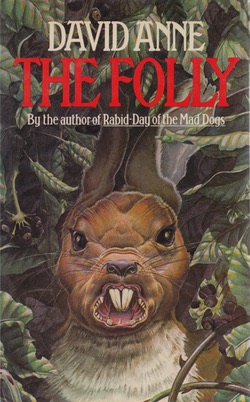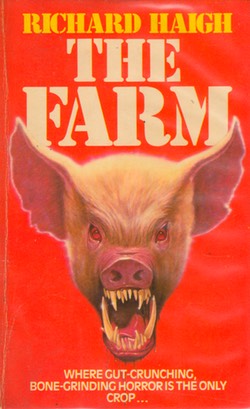Welcome to Freaky Fridays, where we celebrate the one food group no one likes: you. Fortunately, out-of-print paperbacks from the dim and distant past are here to warn us about the menace of the Food Pyramid of Death!
Prepare yourself to meet The Hogs From Hell, little piggies so evil that when they go to market they eat the market. When they stay home, they destroy the home. Everyone likes to eat bacon, right? Well, in the United Kingdom, bacon eats YOU!
Old McDonald had a farm,
ee i ee i o
And on that farm everything wanted to kill you
ee i ee i o
As one character proclaims in The Farm, “There’s no doubt that those bloody pigs mean business.” And the business they mean is death! But these aren’t just random deadly piggies. This is the story of an entire farm on drugs, where every single pig, cow, horse, sheep, chicken, and bunny rabbit is on drugs and these aren’t fun drugs. These are drugs that command them to kill.
With a kill kill here
And a kill kill there
Here a kill
There a kill
Everywhere a kill kill
Old McDonald had a Murder Farm
ee i ee i o…
The United Kingdom has its own horror tradition which, in the Seventies, got very gory, very fast, and ground zero of that pulp explosion was New English Library. The Times Mirror Company of Los Angeles acquired New American Library in 1960 and wanted a British arm. They merged British paperback houses Ace and Four Square to form NEL, and when Gareth Powell became managing director in 1964, the place turned into cult paperback nirvana, pumping out splashy, trashy books aimed at bored teenagers looking for cheap thrills. NEL continued to milk the horror craze and teen market (their 18-volume Skinheads series ran from 1970 to 1980) with beautifully lurid covers until 1981, when they were sold to Hodder & Stoughton and became its mass market imprint until 2004, when they were unceremoniously struck in the back of the head with a shovel and buried beneath the garden shed in a shallow grave generously splashed with quicklime.
Richard Haigh was one of at least 13 pen names that Laurence James wrote under. A former NEL editor, he realized the big money was in writing novels, not editing them, and he wrote four Hells Angel novels (inspired by the Hunter S. Thompson book and some Hells Angel films he’d watched) which he submitted anonymously through a friend to the other editor at NEL. After that, he went on to write 160 novels which sold millions of copies, most famously the first 33 installments of the 125 volume post-apocalyptic Deathlands series. He died in 2000 at the age of 56, leaving behind a swashbuckling literary legacy and two books about killer pigs: The Farm (1984) and The City (1986).
Horror publishing in the United States in the Seventies was all Satan all the time, influenced as it was by Rosemary’s Baby and The Exorcist (with a sideline in killer kids). But in the United Kingdom, their biggest horror star was James Herbert, whose ultra-gory toe-nibbler, The Rats (1974), launched a craze for killer animals that saw overgrown lampreys attack the Channel ferry, jellyfish attack a Totnes hospital, locusts take down Shropshire, and crabs almost destroy humanity.
Now, in Wales, nestled up against the base of the Black Mountains, Dr. Paul Thompson has ditched his cheating wife to buy Hobb’s Farm where he hopes to start over with his girlfriend, Helen, a writer from New York who once wrote a feminist novel, so you know she’s going to come to a bad end. Specializing in massive, bloody set pieces The Farm starts the dominoes falling early when, in what’s an over-the-top parody of a James Herbert gore-shower, there’s a traffic collision between a truck carrying chemicals, a Porsche, a caravan of schoolchildren, and a Morris Minor full of nuns, one of whom dies when the statue of St. Christopher mounted on the dashboard pierces her brain.
The drugs the truck was carrying are Ketamine, DMT (the hallucinogen), and Neostigmine, an inhibiting agent. It forms a party sludge and gets into the drinking water of Hobb’s Farm during a heat wave and the animals, worried about dehydration, slurp up all that lovely sludge until they’re stoned and hallucinating. The first sign of trouble comes when the daughter of some visiting friends picks up a fluffy bunny, gives it a big kiss, and the little fuzzy bites her lips off. The humans chalk it up to the heat, but then the geese come crashing through the parlor windows and try to kill them, then a pair of Collies drive a kite-flying lad off a cliff, where he breaks both his legs and is surrounded by blood-hungry cats.
At this point, the humans do a tally of the livestock on Hobb’s Farm—30 sheep, assorted poultry, two rabbits, a pair of goats, six geese, plenty of rats in barn, two Collie pups, various stray cats, and 127 enormous Buckland White pigs with enormous, curling tusks—then they take a deep gulp and plan their escape. Too late! The farmhouse is quickly surrounded by pigs (“The pigs…Look, they’re coming out,” she shrieked. “Oh, sweet Christ. The pigs!!”) and the humans realize they’re screwed.
James does his best James Herbert impression, right down to making his roughneck farm manager a repugnant clod who’s having an incestuous affair with his 13 year-old daughter, but it doesn’t quite feel as heartfelt as, say, Herbert’s deeply personal hatred for gym teachers. But where James does Herbert proud is in his complete and total cynicism. When the humans devise a plan to run outside, distract the pigs, grab a Volvo, then hit the horn when it’s safe for the children to emerge and hop in the escape vehicle, events unfold such that the pigs manage to kill the Volvo driver, leaving his corpse slumped over the horn. Mistaking it for the safety signal, the little girls run outside directly into a herd of angry pigs who eat them alive.
 Cats claw out eyes, geese come down the chimney, and all hope is lost. Not only that, but the future is a piggy hellscape when the book ends with yet another truck accident that dumps the exact same combination of chemicals into a reservoir that feeds a herd of Buckland Whites heading into London’s Wembley Stadium for an agricultural show. But as The City starts, we learn that the chemicals from that second spill have been rendered inert by London’s superior water filtration system. Doesn’t matter. Thirty Buckland Whites from the first incident have been brought to the stadium for the show anyways, and it turns out that the drugs they took have released a virus (?) in their systems. It’s only a few days into London’s largest agricultural show when misguided animal rights hooligans unleash the pigs and they wind up murdering and eating 50 attendees before the SAS is brought in to machine gun them all into giblets (except for one whose neck is snapped by an American football star).
Cats claw out eyes, geese come down the chimney, and all hope is lost. Not only that, but the future is a piggy hellscape when the book ends with yet another truck accident that dumps the exact same combination of chemicals into a reservoir that feeds a herd of Buckland Whites heading into London’s Wembley Stadium for an agricultural show. But as The City starts, we learn that the chemicals from that second spill have been rendered inert by London’s superior water filtration system. Doesn’t matter. Thirty Buckland Whites from the first incident have been brought to the stadium for the show anyways, and it turns out that the drugs they took have released a virus (?) in their systems. It’s only a few days into London’s largest agricultural show when misguided animal rights hooligans unleash the pigs and they wind up murdering and eating 50 attendees before the SAS is brought in to machine gun them all into giblets (except for one whose neck is snapped by an American football star).
But the novel ends with one surviving pig, impregnated by seven of the Buckland Whites, on a ship bound for Australia. The opening of The City says that this is volume two in “the ‘Pigs’ trilogy” but there never was a book three, and the world is a poorer place for it. Without our killer pigs, we’ll just have to content ourselves with other British books like The Folly. About killer rabbits.










